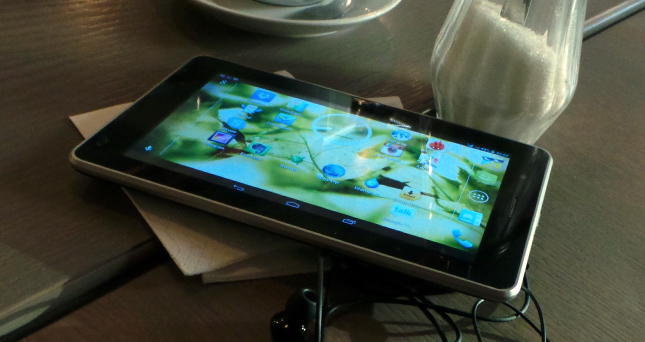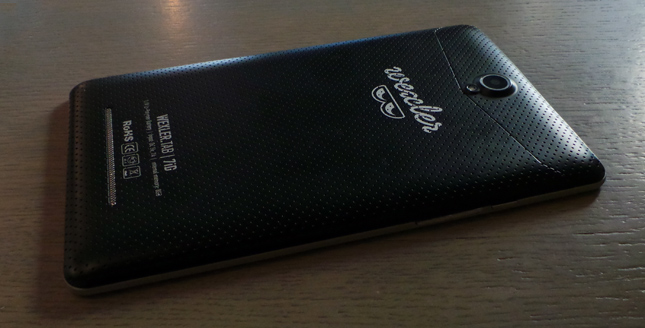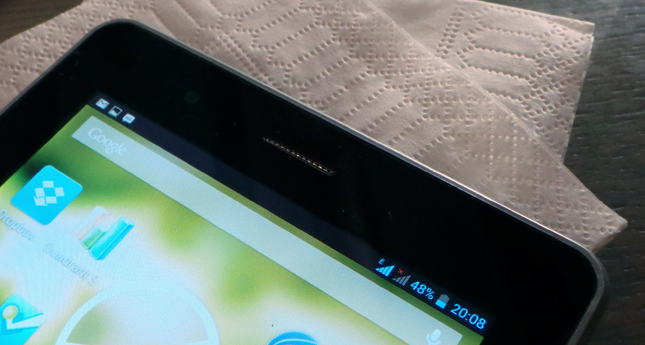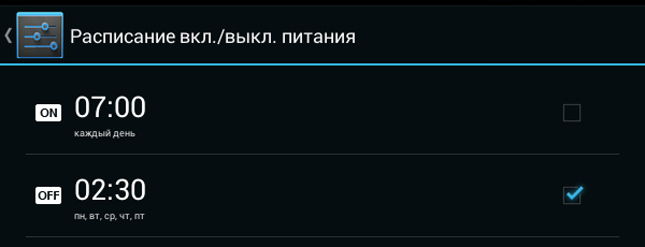Wexler Tab 7iD: almost Nexus with two sim cards
I don’t know how everything actually happens there, but for some reason it’s nice to think that when inventing a new device, the developers are sitting in the kitchen, sipping a beer and a little lazily throwing phrases. How, for example, did Wexler Tab 7iD come up with in this case?

- What if you take Google Nexus 7 ...
- Suppose and-and-and?
- And make it even cheaper!
- The idea is good, but how will we do it? He's so cheap.
- Hmm, well, I don’t know, let’s have a smaller resolution and a dual core process? M?
“And who will need him like this?”
- But the price will drop to 5k - this is not an argument?
- Argument, but still need some kind of trick!
- Well, ok, what's the trend now? Ceiling lamps? Dvuhsimochniki? Let's make him a giant smartphone with two SIM cards! BUT? BUT?! Aaaa ?!
- Damn, that's cool, man! Tomorrow is on the conveyor!
- Phew ... Well, still in a glass?
')
And if no joke, then ...
They gave me to drive the above model. Outwardly, it really is very similar to the Nexus: a corrugated back cover, the same diagonal, the same contours. But there are nuances.

The back cover of Wexler is made of slightly different plastic. It is slightly glossier and therefore collects fingerprints a little faster than the Asus tablet.

The buttons on the left side are not black, but silver and shiny. I will not say whether it is good or bad, but I discovered them faster than on the Nexus, they still stand out.

Even the upper part of the back panel is removed, and under it a pair of SIM slots is already found. The slots are large, so I had to tinker with an adapter on a micro-SIM — I didn’t want to be inserted for a long time. In addition, there is also a nest for microSD, which is quite relevant, because the price of five thousand rubles mentioned is relevant for the youngest configuration with four gigs of main memory on board.

At the top there is a micro-USB port, an audio jack and the same glossy as the previous two on / off buttons. The question is, what a small button then on the gadget on the left side?

It does not respond to short presses, but if you poke into it and hold it longer, a list of eight recently launched programs will appear on the screen. In general, it is convenient, but the touch key with the same functionality is always at the bottom of the screen.

On the sides there is nothing more noteworthy, but there is a speaker above the screen - a conversational speaker! That is, the device can call. You will naturally look weird during a conversation, but in my opinion, this is still better than a missing look and “talk” into the void with a headset.
The display is exactly the same size as the Nexus 7, that is, seven-inch. But the density of points is lower, because the resolution is lower, namely 1024x600 pixels. After the new tablets with FullHD resolution, of course, it seems that it is unclear, but not quite a guard. In addition, the color rendition is normal here, and the viewing angles are under 180º (unless you look at the bottom of the screen - then the picture goes blank), so the impression is generally positive. Well, this module is also cheaper. And energy eats less.
In order to save money, a different iron than Nexus was chosen. The Wexler Tab 7iD uses a dual-core Cortex A9 with a frequency of 1.2 GHz, a gigabyte of RAM, and the graphics of the PowerVR SGX 531.


Memory for any content can be 4, 8 or 16 GB. The price of the device starts from 5k rubles and further in increments of 500 rubles. rises to an unprecedented six thousand.
To say something good about a camera with a 2 megapixel sensor in 2013 is quite difficult. Her strength is enough for something decent only with perfect lighting, respectively, all sorts of Instagram on this tablet more likely turn into programs like read only. However, this is a small but very proud camera! She knows how to pretend that she is eight megapixel by interpolation.
The most interesting thing about this gadget is software. The device is clearly designed not only as a tablet, but also as a navigator. Well, or from it decided to make the navigator at some point by adding profile software. In addition to the standard set of Android 4.1 programs, Navitel (a trial version with a 1-month license) and Yandex.Maps were added here.

And you can also launch the Wexler Play shell, which is a set of large shortcuts that are more convenient to click behind the wheel. Some of the programs are already installed (for example, Cool Reader and EBook Droid), but most of the icons are colored in gray, and this, as it were, suggests to us that they have yet to be installed.
A 4000 mAh battery allows the gadget to work with one SIM card installed (however, what's the difference, the radio module is still one for both slots) and periodically enabled Wi-Fi, BT (by the way, version 4.0) and other programs that the average user usually runs for 11-12 hours. The result is not bad for an Android device. But keep in mind that I continued to make calls using a regular smart, so the load was still distributed. If you also hang a voice connection on the gadget, I think that it will withstand eight to nine hours.

But there is, however, one interesting feature that will help to increase battery life - the price of switching the device on and off. If the tablet turns itself off at night and at the time of the working day, it will ask for charging after about a day and a half.
And yes, which is strange, the company itself in the "laboratory" tests turned out less: reading - up to 8.5 hours; video - up to 6 hours
Everyone decided to release the so-called. “Ceiling lamps,” and Wexler turned out to be no exception. Given the humane price tag, it turned out well. There are, of course, frank gaps in the configuration (yes, there is a lack of a normal camera), but if it had not been for this, the tablet probably would have cost a bit more, and such a beautiful number (4990) would not have worked. Suitable for children or for travel. The movie turns, as a reader, too, well, and a couple of slots for SIM cards as it contributes.
OS: Android 4.1
Processor: Cortex-A9 (2 cores, 1.2 GHz)
Video: PowerVR SGX 531
RAM: 1 GB
Main memory: 4-16 GB + microSD slot
Screen: 7 ", IPS, 1024 x 600
Communications: Wi-Fi (a / b / g / n), Bluetooth 4.0, USB 2.0
Connectors: micro USB, 3.5mm audio jack
Camera: 2 megapixels. + 0.3 megapixels.
Navigation: GPS, GPS
Battery: 4000 mAh
Dimensions: 193 x 119 x 10 mm
Weight: 316 grams
Price: 4990 - 5990 rubles.

- What if you take Google Nexus 7 ...
- Suppose and-and-and?
- And make it even cheaper!
- The idea is good, but how will we do it? He's so cheap.
- Hmm, well, I don’t know, let’s have a smaller resolution and a dual core process? M?
“And who will need him like this?”
- But the price will drop to 5k - this is not an argument?
- Argument, but still need some kind of trick!
- Well, ok, what's the trend now? Ceiling lamps? Dvuhsimochniki? Let's make him a giant smartphone with two SIM cards! BUT? BUT?! Aaaa ?!
- Damn, that's cool, man! Tomorrow is on the conveyor!
- Phew ... Well, still in a glass?
')
And if no joke, then ...
Design
They gave me to drive the above model. Outwardly, it really is very similar to the Nexus: a corrugated back cover, the same diagonal, the same contours. But there are nuances.

The back cover of Wexler is made of slightly different plastic. It is slightly glossier and therefore collects fingerprints a little faster than the Asus tablet.

The buttons on the left side are not black, but silver and shiny. I will not say whether it is good or bad, but I discovered them faster than on the Nexus, they still stand out.

Even the upper part of the back panel is removed, and under it a pair of SIM slots is already found. The slots are large, so I had to tinker with an adapter on a micro-SIM — I didn’t want to be inserted for a long time. In addition, there is also a nest for microSD, which is quite relevant, because the price of five thousand rubles mentioned is relevant for the youngest configuration with four gigs of main memory on board.

At the top there is a micro-USB port, an audio jack and the same glossy as the previous two on / off buttons. The question is, what a small button then on the gadget on the left side?

It does not respond to short presses, but if you poke into it and hold it longer, a list of eight recently launched programs will appear on the screen. In general, it is convenient, but the touch key with the same functionality is always at the bottom of the screen.

On the sides there is nothing more noteworthy, but there is a speaker above the screen - a conversational speaker! That is, the device can call. You will naturally look weird during a conversation, but in my opinion, this is still better than a missing look and “talk” into the void with a headset.
Display
The display is exactly the same size as the Nexus 7, that is, seven-inch. But the density of points is lower, because the resolution is lower, namely 1024x600 pixels. After the new tablets with FullHD resolution, of course, it seems that it is unclear, but not quite a guard. In addition, the color rendition is normal here, and the viewing angles are under 180º (unless you look at the bottom of the screen - then the picture goes blank), so the impression is generally positive. Well, this module is also cheaper. And energy eats less.
Iron
In order to save money, a different iron than Nexus was chosen. The Wexler Tab 7iD uses a dual-core Cortex A9 with a frequency of 1.2 GHz, a gigabyte of RAM, and the graphics of the PowerVR SGX 531.


Memory for any content can be 4, 8 or 16 GB. The price of the device starts from 5k rubles and further in increments of 500 rubles. rises to an unprecedented six thousand.
Camera
To say something good about a camera with a 2 megapixel sensor in 2013 is quite difficult. Her strength is enough for something decent only with perfect lighting, respectively, all sorts of Instagram on this tablet more likely turn into programs like read only. However, this is a small but very proud camera! She knows how to pretend that she is eight megapixel by interpolation.
Soft
The most interesting thing about this gadget is software. The device is clearly designed not only as a tablet, but also as a navigator. Well, or from it decided to make the navigator at some point by adding profile software. In addition to the standard set of Android 4.1 programs, Navitel (a trial version with a 1-month license) and Yandex.Maps were added here.

And you can also launch the Wexler Play shell, which is a set of large shortcuts that are more convenient to click behind the wheel. Some of the programs are already installed (for example, Cool Reader and EBook Droid), but most of the icons are colored in gray, and this, as it were, suggests to us that they have yet to be installed.
Battery
A 4000 mAh battery allows the gadget to work with one SIM card installed (however, what's the difference, the radio module is still one for both slots) and periodically enabled Wi-Fi, BT (by the way, version 4.0) and other programs that the average user usually runs for 11-12 hours. The result is not bad for an Android device. But keep in mind that I continued to make calls using a regular smart, so the load was still distributed. If you also hang a voice connection on the gadget, I think that it will withstand eight to nine hours.

But there is, however, one interesting feature that will help to increase battery life - the price of switching the device on and off. If the tablet turns itself off at night and at the time of the working day, it will ask for charging after about a day and a half.
And yes, which is strange, the company itself in the "laboratory" tests turned out less: reading - up to 8.5 hours; video - up to 6 hours
Summary
Everyone decided to release the so-called. “Ceiling lamps,” and Wexler turned out to be no exception. Given the humane price tag, it turned out well. There are, of course, frank gaps in the configuration (yes, there is a lack of a normal camera), but if it had not been for this, the tablet probably would have cost a bit more, and such a beautiful number (4990) would not have worked. Suitable for children or for travel. The movie turns, as a reader, too, well, and a couple of slots for SIM cards as it contributes.
Specs
OS: Android 4.1
Processor: Cortex-A9 (2 cores, 1.2 GHz)
Video: PowerVR SGX 531
RAM: 1 GB
Main memory: 4-16 GB + microSD slot
Screen: 7 ", IPS, 1024 x 600
Communications: Wi-Fi (a / b / g / n), Bluetooth 4.0, USB 2.0
Connectors: micro USB, 3.5mm audio jack
Camera: 2 megapixels. + 0.3 megapixels.
Navigation: GPS, GPS
Battery: 4000 mAh
Dimensions: 193 x 119 x 10 mm
Weight: 316 grams
Price: 4990 - 5990 rubles.
Source: https://habr.com/ru/post/187978/
All Articles